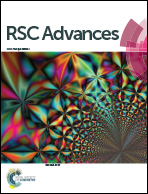Mediator-free biosensor using chitosan capped CdS quantum dots for detection of total cholesterol†
Abstract
We report results of the studies relating to fabrication of an electrochemical mediator-free biosensor platform using in situ synthesized cadmium sulfide quantum dots (CdS QDs) embedded in chitosan (CHIT) via surface functionalization of cholesterol esterase (ChEt) and cholesterol oxidase (ChOx) enzyme molecules. The results of the microscopic studies of CHIT–CdS QDs biocomposite reveal homogeneous dispersion of the embedded CdS QDs in CHIT and specific combinational symmetry of the S2− rich species CdS QDs, with CHIT and ChOx–ChEt molecules. The electrochemical studies exhibit the enhanced redox activated behavior of ChOx–ChEt molecules which in turn is found to depend on the size of the chitosan capped CdS QDs, facilitating the fast diffusion of electrons from ChOx–ChEt to the electrode surface. The biofunctionalized CHIT–CdS QDs based biosensor platform utilized for the estimation of total cholesterol without using any mediator shows high sensitivity (0.384 μA mM−1 cm−2) in a wide detection range (0.64–12.9 mM) of total cholesterol. This Cds QDs based platform has enormous possibilities for the development of biosensors for clinical diagnostics.


 Please wait while we load your content...
Please wait while we load your content...